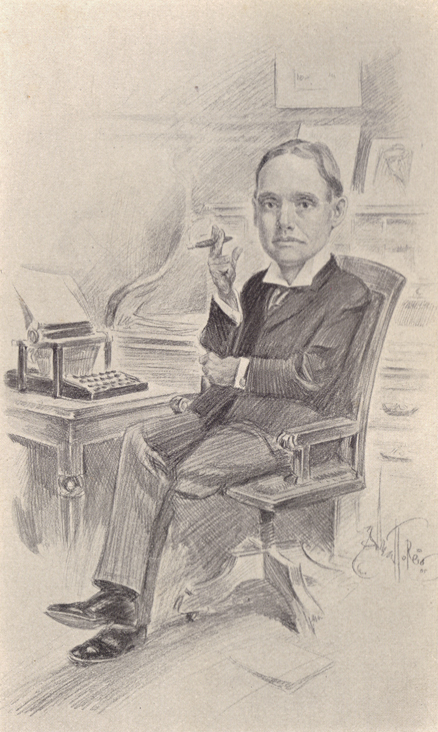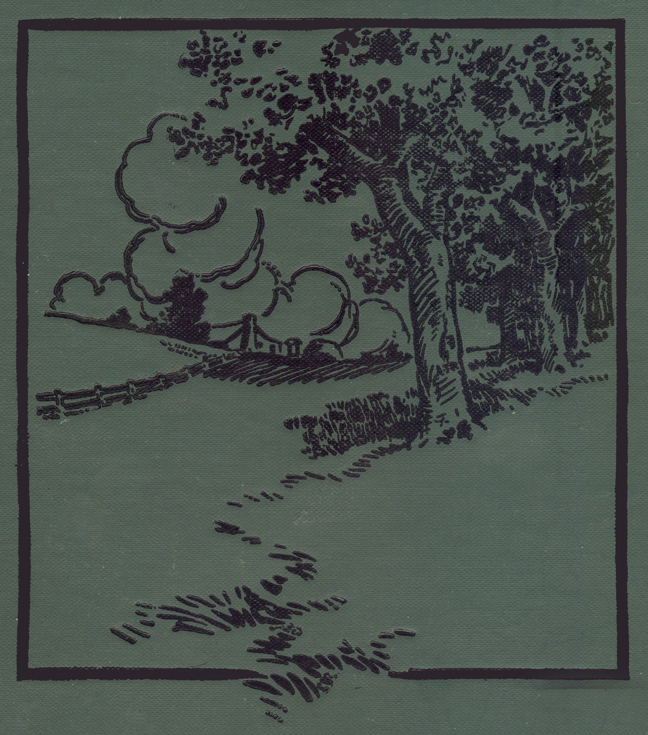
From At the Grass Roots, Comprising “The Christmas of 1883,” and Other Vagrant Sketches, by Elmer House (Dodd Gaston), with Cover Design and Frontispiece by Albert T. Reid, Topeka: Monotyped by Crane & Company, 1905; pp. 50-55.

I often wonder what became of Emma Barnhart, who taught the Doane school for a couple of years along in the early eighties. Miss Barnhart was the first princess I ever knew at all intimately. Up to the time she first shed her effulgent beauty and daintiness upon my young life, I had known only the girls who lived on adjoining farms. They were good, sensible girls, who could milk cows, make butter, set a hen, and in the pinch of harvest-time and haying drive the binder or run a sulky hayrake. But they were, I regret to admit, not so very beautiful or artistic. They wore ill-fitting dress of coarse cloth, big checked aprons, heavy, broad-toed shoes — even rubber boots in muddy weather — and home-made sunbonnets. They were always badly tanned, and in the spring and fall their hands were chapped and red like a boy’s.
51 So when Miss Barnhart came from a neighboring town to teach our school I had my first intimation of the fact that the world was not bounded on the north by Miller’s sawmill, on the east by the Porter Hill bridge, on the south by Salter’s stone barn, and on the west by Rock creek. Miss Barnhart had what I have since learned to describe as an aureole of reddish hair that shone like burnished copper, a delicate, creamy complexion, soft white hands with tapering fingers, and she wore gowns that rustled as she walked, and soft, fluffy things about her neck and wrists.
In many respects Miss Barnhart was a decided innovation to the pupils at Doane. We had been accustomed to big, husky men teachers who whipped the big boys for the slightest infraction of the rules, and who began their day’s work by repairing to a neighboring growth of hedge and cutting six or seven long, stout withes to be used in the exigencies of 52 school government. Miss Barnhart introduced new methods. She began by putting us on honor so far as our behavior was concerned, and let it be known that she did not consider it any particular crime to whisper during school hours. She taught us songs, and we devoted a portion of the study hours every day to singing. In fact, I think she was entirely responsible for the idea, which I was twelve years in shaking off, that I could sing, she having, early in the term, made me leader of one division of the school chorus.
Up to the time of Miss Barnhart’s advent into the neighborhood I had never been called anything but “Dodd,” “you there,” “don’t be all day about it,” or “that little devil.” She greatly surprised and pleased me by calling me “Mr. Gaston.” In fact, she gave all boys over eight the title of “Mr.” and invariably addressed the girls over six as “Miss Lou,” “Miss Ella,” or “Miss Ada,” as the 53 case might be. Before Christmas she was the most popular person I have ever known, and she taught the year out without once being criticised by either parent or pupil, a record which will probably stand for all time.
On the closing day of school there was a big dinner at the schoolhouse, and everybody in the district came in for the dinner and the exercises. At the close Miss Barnhart tried to make a little speech, but she choked up and finally broke down and cried, and then every pupil in school sniffled and the girls blubbered as though their hearts were broken.
Ed Fought, who was the biggest boy in school and who had a certain amount of dignity to sustain, always claimed that he laughed while the others were crying, but I sat in the seat just across the aisle from Ed and saw him wiping his eyes on his shirtsleeve. Ed claimed that as Miss Barnhart was only going to her home twenty miles away to spend the summer 54 there was nothing to cry about, but he couldn’t fool me, although I could see that his sisters believed him implicitly.
Miss Barnhart came back in the fall to teach another year, and was just as popular as before. Of course it is useless for me to say that I had long before made up my mind to marry her when I grew up, and so when the story that she was to be married to a man from a distant town in the spring was first circulated, I was very miserable. At first I scouted the idea, saying that I did not believe Miss Barnhart would marry the best man that ever lived, but it leaked out during the winter that he was coming to see her, and one morning along toward the end of the term he came to school with her and stayed until noon.
I had expected a great deal of Miss Barnhart’s suitor, but he was distinctly disappointing and I couldn’t see what she saw in him. He was a little fat man with a fierce black moustache, who seemed 55 to get his exercise by twirling his watch-chain on his fingers. When he laughed he cackled, and I know now that he must have had an enormous bay window by the time he was forty. He was that sort.
At the close of the school we had another big dinner, and another surprisingly large tearfall. Miss Barnhart packed up her books and things and went away, and I never saw her afterward. I kept hoping that something would happen to break off her engagement, but nothing did happen, and she married the little fat man in the early summer. I was very unhappy for a few days, but I soon got over it, although at long intervals I still find myself thinking about Miss Barnhart and wondering what became of her.
